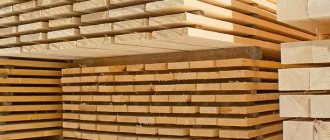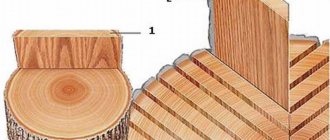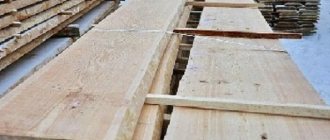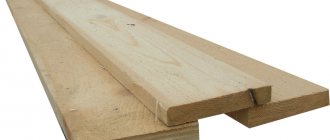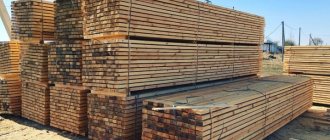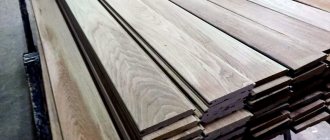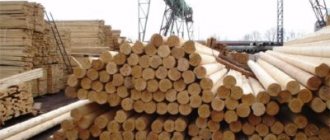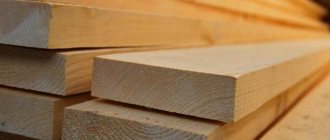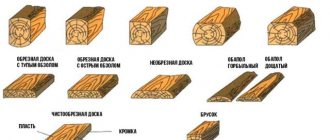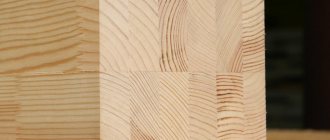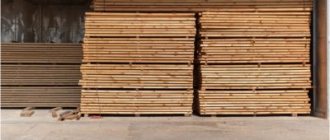The sizes of softwood lumber are regulated by state standards and rules GOST 24454-80. This document applies to edged and unedged materials that are produced for the needs of our country and are also sent for export.
A good master will never order building materials “by eye.” A correctly drawn up estimate for the construction of a house, bathhouse, gazebo and other objects must include the exact amount of lumber. Not everyone will be able to immediately determine how many boards, 6 meters long, are contained in a cube.
A cubic meter is a standard unit of measurement used by all domestic lumber suppliers. If we talk about length, then in addition to footage, you can come across the term “molding”, but this is relevant for the purchase of piece products.
As a rule, boards are not sold in pieces, so you will have to order the required number of cubes. But we need to cover not cubic meters, but square meters, which means we will need to find out the exact number of boards. So how to determine how many pieces will be in one cube?
Helpful information.
Some people ask a very reasonable question - why are boards produced mainly at 6 meters? It's not a matter of the height of the trees, but purely of logistics. Naturally, during the construction of various objects, non-standard lumber may be needed, for example, 7, 8 meters or more. But you will have to pay significantly extra for the delivery of such products, because they can only be loaded onto a road train. Therefore, 6-meter boards are the most common and affordable.
In the calculations below you can see how many lumber with a nominal section of the most popular length of 6 meters fits in 1 cube. It should be noted that the above GOST allows the production and sale of material having dimensions different from those specified in the regulatory document, and in order to calculate their quantity in 1 cubic meter, you must use a simple formula:
n=1/(a*b*c)
, Where
n
– number of boards, beams or beams, pcs;
A
– thickness, m;
b
– width, m;
With
– length, m.
Example
: Let's calculate the number of boards measuring 16x75x6000 mm in 1 m3:
N=1/(0.016*0.075*6)=138.89 pcs
This is a universal formula that is suitable for absolutely any lumber. Thus, the error is reduced to almost zero.
Helpful information.
The sequence of calculations is suitable for absolutely all lumber with flat surfaces. And it doesn’t matter what kind of wood they are made of, the main thing is to know the parameters of each board, beam and lining.
Softwood lumber weight
Softwood lumber is no less popular than hardwood lumber. They are considered lighter and more flexible, which is why the longest elements are made from coniferous trees. The needles are easy to process, they are durable, rot-resistant and obedient - it is convenient to use for carved surfaces, for example, kitchen facades. But determining the weight of such lumber is often difficult. We will explain why below.
It is believed that coniferous trees weigh less than deciduous ones, but consumers may be in for a “surprise” when transporting lumber: the weight of the pieces depends on several factors at once - humidity, degree of processing, and even what part of the tree the raw materials are taken from. Craftsmen learn to recognize a mass of coniferous blanks with experience, but beginners will be helped by a special table developed by experts.
Lumber Tables
Below are detailed data that will immediately allow you to determine the required amount of lumber from 3 to 6 meters in length. It is very easy to use these tables - we find the required product sizes and see the amount of material and the volume of one element.
Helpful information.
Please note that these tables are approximate results. Doing your own calculations is more accurate. In addition, different manufacturers approach the stacking of lumber in their own way, so the density of the products can vary greatly. Therefore, make a reserve of about 10-20%, otherwise you will have to pay for delivery again.
Table 1.
Number of boards in 1 cubic meter of materials.
Table 2.
Amount of timber in 1 cubic meter of materials.
Table 3.
The amount of lining in 1 cubic meter of materials.
Kubaturnik: timber conversion tables
| Edged board | 20*100*6000mm | 83,3 | 500 | 0,012 | 0,6 | 9 |
| Edged board | 20*150*6000mm | 55,6 | 333,3 | 0,018 | 0,9 | 13,5 |
| Edged board | 22*125*6000mm | 60,6 | 363,6 | 0,0165 | 0,75 | 12,375 |
| Edged board | 22*150*6000mm | 50,5 | 303 | 0,0198 | 0,09 | 14,85 |
| Edged board | 22*175*6000mm | 43,3 | 259,7 | 0,0231 | 1,05 | 17,325 |
| Edged board | 22*200*6000mm | 37,9 | 227,3 | 0,0264 | 1,2 | 19,8 |
| Edged board | 22*225*6000mm | 33,7 | 202 | 0,0297 | 1,35 | 22,275 |
| Edged board | 22*250*6000mm | 30,3 | 181,8 | 0,033 | 1,5 | 24,75 |
| Edged board | 25*100*6000mm | 66,7 | 400 | 0,015 | 0,6 | 11,25 |
| Edged board | 25*175*6000mm | 38,1 | 228,6 | 0,02625 | 1,05 | 19,69 |
| Edged board | 25*200*6000mm | 33,3 | 200 | 0,03 | 1,2 | 22,5 |
| Edged board | 25*225*6000mm | 29,6 | 177,8 | 0,03375 | 1,35 | 25,31 |
| Edged board | 25*250*6000mm | 26,7 | 160 | 0,0375 | 1,5 | 28,125 |
| Edged board | 32*100*6000mm | 52,1 | 312,5 | 0,0192 | 0,6 | 14,4 |
| Edged board | 32*125*6000mm | 41,7 | 250 | 0,024 | 0,75 | 18 |
| Edged board | 32*150*6000mm | 34,7 | 208,3 | 0,0288 | 0,9 | 21,6 |
| Edged board | 32*175*6000mm | 29,8 | 178,6 | 0,0336 | 1,05 | 25,2 |
| Edged board | 32*200*6000mm | 26 | 156,3 | 0,0384 | 1,2 | 28,8 |
| Edged board | 32*225*6000mm | 23,1 | 138,9 | 0,0432 | 1,35 | 32,4 |
| Edged board | 32*250*6000mm | 20,8 | 125 | 0,048 | 1,5 | 36 |
| Edged board | 40*100*6000mm | 41,7 | 250 | 0,024 | 0,6 | 18 |
| Edged board | 40*125*6000mm | 33,3 | 200 | 0,03 | 0,75 | 22,5 |
| Edged board | 40*150*6000mm | 27,8 | 166,7 | 0,036 | 0,9 | 27 |
| Edged board | 40*175*6000mm | 23,8 | 142,9 | 0,042 | 1,05 | 31,5 |
| Edged board | 40*200*6000mm | 20,8 | 125 | 0,048 | 1,2 | 36 |
| Edged board | 40*225*6000mm | 18,5 | 111,1 | 0,054 | 1,35 | 40,5 |
| Edged board | 40*250*6000mm | 16,7 | 100 | 0,06 | 1,5 | 45 |
| Edged board | 50*100*6000mm | 33,3 | 200 | 0,03 | 0,6 | 22,5 |
| Edged board | 50*125*6000mm | 26,7 | 160 | 0,0375 | 0,75 | 28,125 |
| Edged board | 50*150*6000mm | 22,2 | 133,3 | 0,045 | 0,9 | 33,75 |
| Edged board | 50*175*6000mm | 19 | 114,3 | 0,0525 | 1,05 | 39,375 |
| Edged board | 50*200*6000mm | 16,7 | 100 | 0,06 | 1,2 | 45 |
| Edged board | 50*225*6000mm | 14,8 | 88,9 | 0,0675 | 1,35 | 50,625 |
| Edged board | 50*250*6000mm | 13,3 | 80 | 0,075 | 1,5 | 56,25 |
| Name | One piece size | Number of pieces | Number of linear meters | Volume of one piece | Weight of one piece, kg | |
| mm (millimetre) | in one cubic meter | in one cubic meter | cubic meters | (at 20% humidity) | ||
| Bar | 50*50*6000mm | 66,67 | 400 | 0,015 | 11,25 | |
| timber | 50*100*6000mm | 33,33 | 200 | 0,03 | 22,5 | |
| Bar | 60*60*6000mm | 46,3 | 277,78 | 0,0216 | 16,2 | |
| timber | 60*100*6000mm | 27,78 | 166,67 | 0,036 | 27 | |
| timber | 100*100*6000mm | 16,67 | 100 | 0,06 | 45 | |
| timber | 100*150*6000mm | 11,11 | 66,67 | 0,09 | 67,5 | |
| timber | 100*200*6000mm | 8,33 | 50 | 0,12 | 90 | |
| timber | 100*250*6000mm | 6,67 | 40 | 0,15 | 112,5 | |
| timber | 125*125*6000mm | 10,67 | 64 | 0,09375 | 70,31 | |
| timber | 150*150*6000mm | 7,41 | 44,44 | 0,135 | 101,25 | |
| timber | 200*200*6000mm | 4,17 | 25 | 0,24 | 180 | |
| timber | 200*250*6000mm | 3,33 | 20 | 0,3 | 225 | |
| timber | 250*250*6000mm | 2,67 | 16 | 281,25 |
Name of
lumber
Table of reference density values for tree species
Since standardized density values for wood have a group appearance, I had to look through English reference books to collect density values by tree species. The result is the following table:
Wood density of the most common tree species
| Wood species | Wood density kg/m³ |
| Balsa (Balsa) | 120-160 |
| Siberian fir | 390-430 |
| Northern spruce | 400-450 |
| Sequoia evergreen | 410 |
| Poplar | 400-500 |
| Willow | 460 |
| Pine | 450-500 |
| Alder | 490 |
| Aspen | 510 |
| Linden | 530 |
| Red tree | 540 |
| horse chestnut | 560 |
| Edible chestnut | 590 |
| Cypress | 600 |
| Bird cherry | 610 |
| Sapelli | 620 |
| Hazel | 630 |
| Walnut | 640 |
| Birch | 650 |
| Cherry | 660 |
| Smooth elm | 660 |
| Larch | 660 |
| Field maple | 670 |
| Teak | 670 |
| Pear | 690 |
| Oak | 690 |
| Afromosia | 700 |
| Switenia (mahogany) | 700 |
| Sycamore | 700 |
| Zhoster (buckthorn) | 710 |
| Beech | 720 |
| Hornbeam | 750 |
| Paduc | 750 |
| Tiss | 750 |
| Ash | 750 |
| Dussia | 800 |
| Kempas | 800 |
| Plum | 800 |
| Lilac | 800 |
| Hawthorn | 800 |
| Rosewood | 800 — 1000 |
| Pecan (cariah) | 830 |
| Yarra | 830 |
| Merbau | 840 |
| Jatoba (mareil) | 840 |
| Keruing | 850 |
| Kulahi | 850 |
| Turmoil | 850 |
| Wenge | 900 |
| Lapacho | 900 |
| Olive | 900 |
| Sandalwood | 900 |
| Panga-panga | 950 |
| Boxwood | 960 |
| Lim | 970 |
| Sucupira | 1 000 |
| Kumara | 1 100 |
| Ebony (Persimmon) | 1 080 |
| Ebony | 1 160 |
| Quebracho | 1 210 |
| Guaiacum or bakout | 1 280 |
Practical meaning and importance of the specific gravity of oak
Among oak preparations, there are wet, dry, dried and raw types. However, the terms themselves do not give a clear idea of the percentage of moisture, so it is extremely important to know the indicator more or less accurately. This is also due to the fact that when performing certain types of construction work, GOST standards for use are established. Thus, when manufacturing products intended for placement in an open area, the standards stipulate from 11 to 14% humidity; in the manufacture of products for indoor use - from 8 to 10%; in parquet production – from 6 to 8%.
The influence of density on weight category
Density is another important factor affecting the weight of wood. As a rule, iron and ebony have the highest densities, the values of which vary from 1100 kg/m3 to 1350 kg/m3. Closer figures can be provided by boxwood and bog oak - from 950 kg/m3 to 1100 kg/m3. Before calculating how much a cube of oak, beech, pear or hornbeam boards weighs, you should take into account their density, which is approximately 700 kg/m3. Pine and bamboo have the lowest density - 500 kg/m3, and balsa wood has the lowest density - 140 kg/m3.
Fencing installation methods
All structures consist of the main elements:
- supports or pillars;
- frame;
- face covering.
Two cubes of a two-meter picket fence
Edged lumber is used for the construction of any type of fence. The most common options:
- Ladder (herringbone) is a parquet method of installing fence slats. Constructed for double-sided fences. Vertical or horizontal boards are attached to the longitudinal frame at an angle. Each plank is placed with a small gap, overlapping the adjacent element. An important feature: the area behind the fence is not visible, it allows air to pass through well.
- A picket fence is a simple fence made from boards. The planks are mounted to the frame. A certain step is established between elements. The boards are fastened with nails or self-tapping screws. The advantage of the design: it is quickly erected, is not material-intensive, and looks aesthetically pleasing.
- Checkerboard - two sides of the fence have a front view. The planks are mounted with or without a gap in a horizontal or vertical position. Pillars are installed between the sections of boards.
- The lattice is a decorative fence. Mounted in one or two rows in the form of crossed elements. It is necessary to make accurate calculations first. The purchase is made with a stock of boards of 10–13 percent.
Unedged fencing board
Does the mass depend on the moisture level in the material?
The moisture content is the ratio of the weight of water present in wood to its mass. This percentage is always greater than zero, since water is an important part of the tree and is contained in it in a specific amount. The higher the percentage of its content in the tree, the greater the weight of the material. The volume and density of wood depends on this indicator.
As you know, the greatest weight and volume is that of the material that has natural moisture. The concept can be described in the following ways:
1. In the narrow sense. Freshly cut forest has a moisture content ranging from 40 to 110%. Moreover, the percentage depends on the species and season when the tree was cut down. Different parts of the tree have different initial moisture content. Logs from the top are lighter than those from the butt. The moisture percentage of the sapwood is higher than that of the heartwood. As it dries, it levels out in different parts of the trunk to the same state. As a rule, wood with initial moisture weighs several times heavier than dry wood.
2. In a broad sense. This is wood and lumber above the saturation point of the fibers, that is, when a balance of humidity with street air is achieved, and water from the wood stops evaporating. This indicator is different for different breeds and is determined by the temperature regime and the level of atmospheric pressure. For convenience, use the standard indicator specified in GOST - 22%. It follows from this that all materials with a moisture content above this level should be classified as materials with natural moisture.
Lumber with a natural moisture content is popular among consumers due to its availability. Without preliminary drying, they are used extremely rarely, since they shrink and are subject to deformation. Therefore, after purchase, raw wood is dried to the required level of moisture in the composition.
Pine log weight
Ready-made lumber is not always used in construction. Sometimes wood is purchased in logs.
Therefore, the question arises: how much does a cubic meter of pine logs weigh and does it differ in weight from other lumber?
The weight of logs also depends on their moisture content. Freshly cut logs, depending on the weather and season, can have a moisture content of 65-85%. If the forest has had time to lie down in clear weather without precipitation, then its humidity can be 15-25%.
Approximate weight of pine logs per 1 cubic meter of logs:
- Fresh – humidity over 70% – weight from 750 to 820 kg;
- Humidity 70% – 720kg/cubic meter;
- Humidity 25% - 540 kg;
- Dry wood 10-18% - 470-510 kg.
Based on the numbers, it can be analyzed that the weight of a cubic meter of logs and lumber of the same type of wood does not differ.
Still have questions?
Our consultants can select the material of the required quality and advise on dimensions, installation and processing.
- Our contacts
or call the number or send your request by email
Contact us!
You might be interested!
How many boards are there in a cube of 25x100x6000? All useful tips Advantages of decking boards TOP 10
